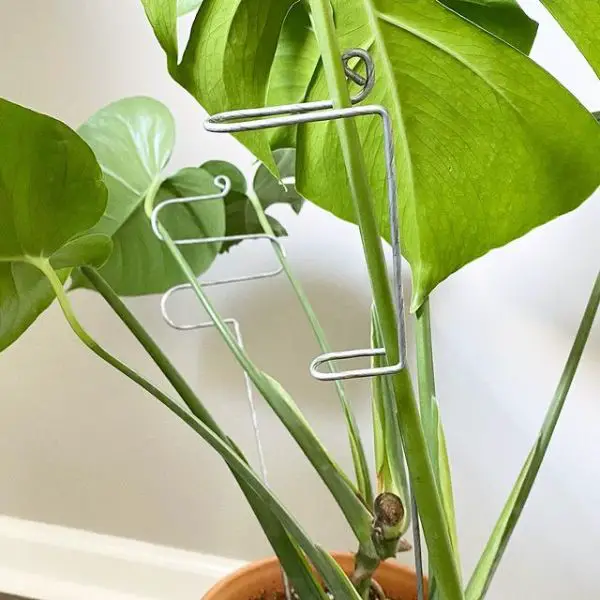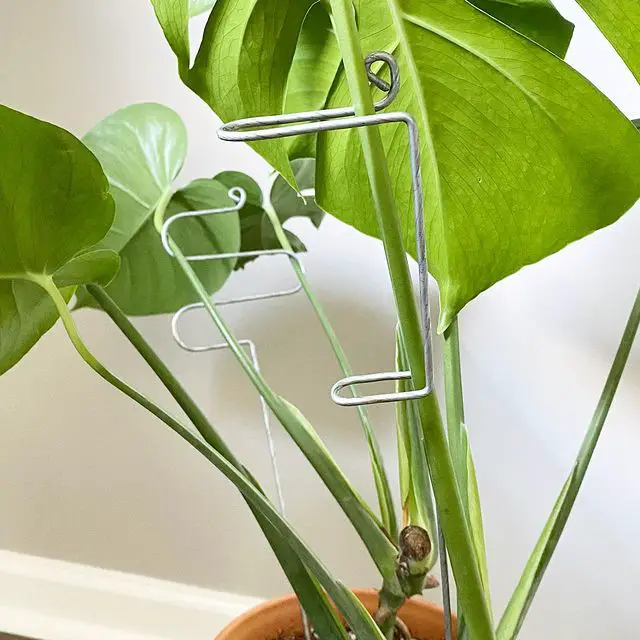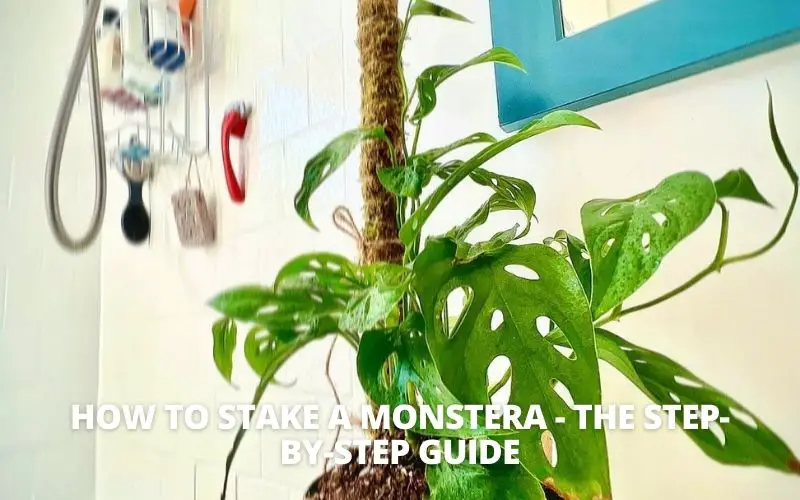Do you have a Monstera plant at home? If so, then you know how important it is to stake them properly! In this blog post, we will give you a step-by-step guide on staking a Monstera. This will ensure that your plant grows in the right direction and doesn’t fall over. Let’s get started.
How to stake a Monstera?
First, you will need to find a good spot for your plant. Make sure that the area gets plenty of light and has good drainage. Once you have found the perfect spot, it’s time to stake your plant.
You will need to use a strong and sturdy stake for this and some necessary materials. We recommend using a bamboo or metal stake.
Materials Required for Monstera Staking
- Monstera in a pot
- Bamboo poles
- Coir
- Soft Plant Ties
- Cotton thread
Now that you’ve learned what materials you’ll need to stake your Monstera, continue to go over the steps.
Step 1: Soil preparation
Before installing your stake, the soil must be prepared. The stake could harm your Monstera plant’s roots if it is inserted improperly.
Gently agitate the ground close to the Monstera stem. Make enough room to find the stem that weighs the most and needs support.
Remove as much soil as you can from the roots that are directly affixed to the stated stem.
Step 2: Put the stake into the ground
After choosing the best soil for Monstera and the spot have been located and prepared, dig the stake using a garden spade or another long-handled tool.
Dig deeper after making little holes until there is enough room for the stake to stand shakily.
Manage the stake to give the heaviest stem the best possible support. It can be moved if necessary.
Add the previously removed soil after setting the stake to help it stay in place and prevent sagging. Make certain the bottom of the pot is touched.
Step 3: Use Support Materials
Support materials are now merely decorative extras if the prior phases were completed correctly. However, it never hurts to be cautious.
Use tapes, twines, or hemp ropes to add an additional backbone on top of the stake support.
Just be careful not to secure the Monstera stems to the stakes too tightly to prevent harm. They should be firmly rooted, not choked.
Lay the stake in the new pot and cover it with the earth to keep it straight.
Your plant will thank you for staking it! Staking your plant will help it to grow taller and healthier. It will also encourage your plant to produce more leaves. In addition, staking your plant will keep it from falling over. All in all, staking is a great way to care for your Monstera plant!
The advantages of staking a Monstera Deliciosa are listed below:
- The plant may be trained to grow in a specific direction by staking it. If you choose not to stake your Monstera plant, you would be forced to manage the space much more carefully
- Without staking, a Monstera will grow in the direction of the light. Uni-direction growth will cause risks to be tripped over and sneaky tripping to occur. It may possibly simply fall over
- Monsteras grown with moss poles have a tendency to have bigger leaves and fenestration, or holes in the leaf. It will fenestrate more quickly, giving your environment a more aesthetically pleasing feel
Signs That Your Monstera Plant Needs Staking
After knowing how to stake a Monstera, consider the following to see if your Monstera is ready for a stake.

Sign 1. They begin to exhibit aerial roots
When a Monstera plant finds enough support, it will begin to produce aerial roots. When aerial roots form, they will begin to rise.
Some individuals choose to prune or bury the aerial roots in the ground. If Monstera is positioned in a confined area, doing so is excellent.
To give Monstera more room to spread out on your property, stake them while their aerial roots are still growing.
Giving them additional assistance, such as moss poles or trellises, will guide their development.
If you want to teach your Monstera plant, aerial roots are excellent signs.
Read More: What to do with Monstera aerial roots? Can I cut them?
Sign 2. They begin to expand horizontally
Your Monstera may begin to grow broader rather than taller after a few years or even months.
You will probably soon be walking beneath a very green roof if you don’t stake and train your Monstera while it’s still developing.
Horizontal growth might be more enjoyable than difficult if you have a special place for plants, such as a greenhouse or a plant room in your flat.
But first, trim the branches if the Monstera addition is in your personal area. Staking will improve both spatial management and the promotion of vertical growth.
Sign 3. The Major Stem Begins to Droop
Without staking, the Monstera plant will droop due to the large, broad leaves’ inherent horizontal development.
The broad leaves that the plants naturally generate are what cause them to droop axially naturally.
To ensure that sure heavier leaves receive more support than others, weight distribution and strategic placement are essential. It could be able to fix the drooping problem.
Interestingly, the primary stem—from which all the leaves emerge—will begin to droop at a specific angle before you know your Monstera needs extra support.
Your Monstera baby might entirely shatter as a result of this.
Sign 4. Monstera is Already a Few Years Old
If you’ve had your Monstera plant at your house or workplace for a while and haven’t seen any of the aforementioned symptoms, it’s time to repot or transfer.
Like any other indoor or outdoor plant, a Monstera plant will develop according to the container it is housed in.
It’s time to prod your Monstera plant If your Monstera plant has sat idly beside you for a while.
To reduce the possibility of death or damage, stake your Monstera plant in both the old and the new container.
How to keep Monstera upright
One of the most common problems with monstera is that it tends to become top-heavy and falls over as it grows. There are a few things you can do to prevent this from happening.
First, make sure to choose a pot that is heavy and sturdy enough to support the plant. A clay pot is ideal, as it will help to anchor the plant in place.
Second, be sure to water the plant regularly, as monstera needs moist soil to stay healthy.
Third, provide support for the plant by tying it to a stake or trellis. By taking these precautions, you can help keep your monstera upright and healthy for many years to come.

Some Typical Staking method
There are many different ways that you can stake your plant, but we will just be covering a few of the most popular methods.
Method 1. Simple Straight Stake
This is the most common and straightforward method. You will need to find a straight stake that is taller than your plant. Drive the stake into the ground next to your plant. Tie the main stem of your plant to the stake using twine or wire. Be sure to leave some slack so that your plant can grow freely.
For this method, you will need:
- A straight stake that is taller than your plant
- Twine or wire
- A hammer or mallet
Instructions:
- Drive the stake into the ground next to your plant
- Tie the main stem of your plant to the stake using twine or wire
- Be sure to leave some slack so that your plant can grow freely
Benefits: This method is simple and easy to do. It is also very effective in helping your plant to grow upright.
Drawbacks: If not done properly, this method can damage the main stem of your plant.
Method 2. The guy-wire
For this method, you will need:
- A straight stake that is taller than your plant
- Twine or wire – A hammer or mallet
- Guy wires (You can purchase these at your local hardware store)
Instructions:
- Drive the stake into the ground next to your plant
- Tie the main stem of your plant to the stake using twine or wire
- Be sure to leave some slack so that your plant can grow freely
- Attach guy wires to the top of the stake and secure them in place
Benefits: This method is very effective in helping your plant to grow upright. It is also more secure than the simple straight stake method.
Drawbacks: This method can be more time-consuming and difficult to do.
Method 3. The basket
For this method, you will need:
- A hanging basket
- Potting mix
- A stake
- Twine or wire
Instructions:
- Fill the hanging basket with potting mix
- Gently place your plant in the basket and secure it in place
- Drive the stake into the ground next to the basket
- Tie the basket to the stake using twine or wire
- Be sure to leave some slack so that your plant can grow freely
Benefits: This method is very effective in helping your plant to grow upright. It also allows your plant to have more room to grow.
Drawbacks: This method can be more expensive than the other methods.
No matter which staking method you choose, be sure to do it carefully and gently. Staking your plant is a great way to help it grow taller and healthier. With a little bit of care, your Monstera plant will thrive.


